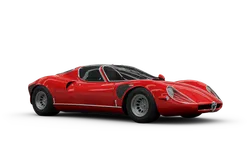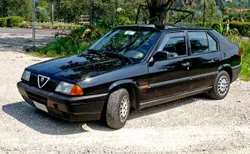

Alfa Romeo 33 Generation 1 Facelift 1986
Explore the Alfa Romeo 33, focusing on the Generation 1 facelift from 1986. Discover its features and history, highlighting its unique appeal in Portugal.
The Alfa Romeo 33, a compact car that debuted in 1983, has garnered a reputation for its distinctive design and spirited performance. The Generation 1 model, particularly the 1986 facelift, is celebrat...
Technical Specifications
Select Version
Dimensions
Engine
Driving
Others
History and Features
Mycarro AI
Apr 26, 2025
The Alfa Romeo 33, a compact car that debuted in 1983, has garnered a reputation for its distinctive design and spirited performance. The Generation 1 model, particularly the 1986 facelift, is celebrated for enhancing the original's appeal without compromising its character. This article delves into the notable features, design elements, and technical specifications of the facelifted model, illustrating why it remains a cherished piece of automotive history.
Design and Exterior Features
With the facelift carried out in 1986, the Alfa Romeo 33 underwent subtle yet impactful changes. The new model sported a slightly modified front fascia, which included refined headlights and a more prominent grille. These changes gave the car a fresher, more aggressive look that was well received by enthusiasts. The side profile remained true to the original's Italian design, characterized by its hatchback silhouette and well-defined lines. The addition of new alloy wheel designs and updated color options further enhanced the visual appeal, allowing buyers to customize their vehicles to suit their tastes.
Interior Comfort and Technology
The interior of the 1986 Alfa Romeo 33 facelift continued to prioritize driver comfort and functionality. Although compact, the cabin was designed with thoughtful ergonomics in mind. The layout was clean and straightforward, featuring a dashboard that prioritized visibility and ease of use. Notably, the new model included improvements in upholstery materials, providing a more refined ambiance. The seats were supportive, ensuring that both the driver and passengers could enjoy long journeys without discomfort.
In terms of technology, the facelift included enhancements to the audio system and climate control options, reflecting the burgeoning trend of driver-centric features in the 1980s. While it might not compete with modern-day technological advancements, the inclusion of features such as a cassette player and optional power windows made the 33 a step above its contemporaries.
Performance and Driving Dynamics
One of the standout characteristics of the Alfa Romeo 33 was its dynamic driving experience. The facelifted model retained the engaging performance of its predecessor, thanks to a range of engine options available to buyers. The most popular engine was the 1.7-liter boxer four-cylinder, which produced approximately 118 horsepower. This engine, paired with the car’s lightweight construction, offered an exhilarating acceleration that made the 33 a joy to drive on both urban roads and winding country lanes.
Moreover, the driving dynamics were elevated by the vehicle's front-wheel-drive layout and well-tuned suspension. The agrarian handling was indicative of Alfa Romeo's long-standing motorsport heritage, ensuring that drivers could navigate corners with confidence and precision. This blend of power and handling made the Alfa Romeo 33 a desirable car for driving enthusiasts.
Safety Features
The 1986 facelift also introduced improvements in safety features, a focus that would become increasingly important as automotive regulations evolved in the late 1980s. Innovations included enhanced crumple zones and improved seatbelt systems aimed at providing better protection for occupants in the event of a collision. While airbags were not yet commonplace at this time, the 33 laid the groundwork for future safety advancements within the Alfa Romeo lineup.
Market Reception and Competition
Upon its release, the Alfa Romeo 33 1986 facelift received positive acclaim from automotive critics and enthusiasts alike. It was lauded for its unique character and spirited performance, distinguishing itself from competitors like the Volkswagen Golf and Ford Escort. Buyers were enchanted by its blend of Italian styling, driving excitement, and practicality. The 33's position in the compact car segment was solidified, becoming a symbol of Alfa Romeo's commitment to delivering stylish and performance-oriented vehicles.
Legacy and Conclusion
The Alfa Romeo 33 Generation 1, particularly the facelift model of 1986, represents a significant era in the brand's history. It combined aesthetic flair with innovative engineering, and its influence can still be seen in modern Alfa Romeo designs. Today, the 33 is considered a classic car, loved for its spirited driving experience and timeless design. Collectors and enthusiasts continue to cherish it for embodying the essence of Alfa Romeo's philosophy: "La Dolce Vita" — the sweet life through the art of driving.
